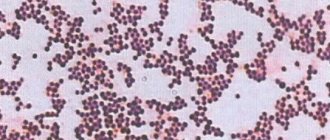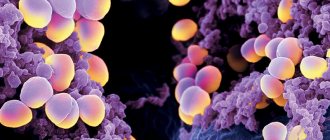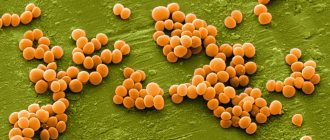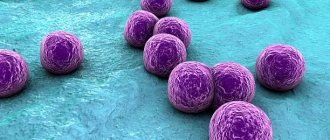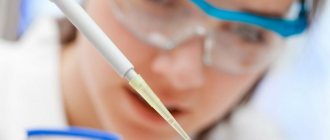Infection with staphylococci is currently considered a common cause of infectious diseases. Not all types of these bacteria, which are widespread in the external environment, are particularly dangerous to human health. The most aggressive microorganism is considered to be the Aureus subspecies (Staphylococcus aureus), called golden for its color.
Up to 40% of the healthy population are carriers of the microbe without even knowing it. Exceeding the norm can be judged by the number of bacteria in a smear taken from the throat or other mucous membranes affected by the purulent-inflammatory process.
Why are Staphylococcus Aureus bacteria dangerous?
Staphylococci belong to the family of spherical anaerobic bacteria, which are responsible for many infectious diseases (pneumonia, meningitis, external and internal infections). The pathogen from the group of gram-positive cocci is found not only in the environment. Colonies of staphylococcus constantly live on the skin, populating the mucous membrane of the nasal cavity and oropharynx.
As long as a person's immunity level does not fall below normal, microbes do not pose a particular threat. With the weakening of immune defense, the population of staphylococci rapidly increases and they become pathogenic. Bacteria penetrate deep into the skin, and when they enter the bloodstream, they provoke general intoxication of the tissues of internal organs, bones and joints.
Of all the varieties of staphylococci, the following groups are distinguished:
- Hemolytic. This type of microbe causes purulent lesions of the upper respiratory tract, which is difficult to cure.
- Golden. The microorganism, resistant to most antibiotics, affects the skin, mucous membranes, and gastrointestinal tract.
- Epidermal. When the immune system is weakened, the pathogen enters the bloodstream during surgery.
- Saprophytic. The bacterium is less dangerous, but its uncontrolled reproduction in the body causes general intoxication.
Staphylococcus aureus is the most dangerous for humans due to the extreme stability of the microorganism, which mainly populates the nasopharyngeal mucosa. Much less frequently, Staphylococcus aureus is detected in a smear from the vagina and gastrointestinal tract. On the surface of the skin, populations of bacteria inhabit the armpits and groin area.
Factors of high pathogenicity of Staphylococcus aureus:
| Name | brief information |
| High stability | S. aureus is not afraid of many types of antiseptics, high temperatures and direct sunlight. Pathogens are not killed by freezing, drying, or boiling; they cannot be destroyed by hydrogen peroxide and alcohol solutions. |
| High vitality | The bacterium does not die from the action of a wide group of antibiotics due to the enzymes it produces. Penicillinase and lidase protect the microbe during treatment with penicillins and help it penetrate the subcutaneous tissue. |
| High toxicity | The production of endotoxin by Aureus causes general intoxication, accompanied by purulent-inflammatory lesions. Under the influence of the toxin, the condition can be complicated by septic shock, abscesses, and dysfunction of body systems. |
An important point: immunity to the attack of Staphylococcus aureus is not developed. After recovery, a person who has had an infection runs the risk of suffering from re-infection. Staphylococcus aureus is especially dangerous for infants in the maternity hospital, since the bacterium is a hospital-acquired infection.
Risk factors for infection with Staphylococcus aureus
Staphylococcus Aureus (the norm in a throat smear does not pose a threat to health) is always present as a representative of the normal microflora. As a result of the activation of bacterial activity for various reasons, their number rapidly increases, provoking the development of a wide range of diseases.
The group of people at risk of infection with S. Aureus includes persons in the following categories:
- Patients suffering from inflammatory diseases of the oral cavity (caries), bronchopulmonary pathologies (emphysema, cystic fibrosis). Treatment of tumor processes, inflammation of the mucous membranes, skin, genitourinary system, burns and purulent wounds is often complicated by the activation of staphylococcus.
- In people with a weakened immune system, problems with endocrinology and the gastrointestinal tract, staphylococcus in the smear periodically exceeds the norm. At risk are also patients after surgical operations, those who have suffered serious illnesses, and those who have been taking antibiotics for a long time.
- In the high-risk category are patients with AIDS, a group of injection drug addicts, as well as patients after implantation of foreign bodies (prostheses, catheters). Systemic intake of hormonal and antitumor drugs, stay in the maternity hospital (mother and baby) are considered easy routes of infection with S. Aureus.
Medical personnel who work with cultures of various microorganisms, come into contact with solutions of biological fluids, samples of tissue structures, and infectious patients are at high risk.
Symptoms of staph infection
Aerobic bacteria can be found on the surface of the skin even in a healthy person, so you shouldn’t be surprised by its presence. The infection will develop only if provoking factors “work” - reduced immunity, viral disease, surgery, trauma, sexually transmitted infection, and so on. It is generally accepted that after a laboratory examination of cultures of biomaterial taken from different places in the body, it is possible to identify the true threat of the presence of staphylococcus. Doctors distinguish several degrees of the presence of colonies of aerobic bacteria. If colonies are found within 10, and the degree is 6, then this is the highest limit of normal. Higher values will indicate severe pathology. Having received the test result “Staphylococcus aureus on the skin 10 to the power of 5”, there is no need to worry - the treatment will be short-lived and will always have a positive result.
Diseases caused by the aerobic bacterium in question do not have any distinctive features. If Staphylococcus aureus infects the throat, then a person may develop sore throat, pharyngitis and laryngitis, which are characterized by a severe course with high body temperature and severe weakness. Diseases of the respiratory group with frequent relapses are considered the main sign of the presence of bacteria in the pharynx.
In addition, Staphylococcus aureus can be detected:
- in bone tissue – infection occurs during fractures or severe wounds;
- in boils, carbuncles and abscesses - as a rule, the hair follicle becomes infected, and the inflammation process starts again and again even during treatment;
- on the skin – the child develops rashes and dermatitis.
Staphylococcus aureus is often detected in the feces of infants. This can be diagnosed in the maternity hospital - infection occurs during difficult childbirth against the background of reduced immunity in premature babies or infants with congenital pathologies.
The most serious condition when infected with an aerobic bacterium is toxic shock. It is characterized by characteristic symptoms - a sharp increase in temperature to critical levels, nausea, acute pain in the head, a rash on the body, and the appearance of purulent discharge from existing wounds. In this case, no research is carried out - only Staphylococcus aureus can cause this condition. Urgent therapy is prescribed.
What test determines the presence of Staphylococcus aureus
The most typical habitat for Staphylococcus aureus is the upper parts of the nasal passages and the respiratory tract. If the number of microbes is normal, they belong to the opportunistic (permanent) flora; exceeding the limit values turns Aureus into an aggressive pathogen that causes septic lesions.
In this case, the main symptoms of intoxication rapidly develop:
- increase in temperature indicators;
- lack of desire to eat;
- signs of weakness and drowsiness.
Staphylococcus Aureus (the norm in a throat smear is 10 to 3 degrees) is distinguished by the production of aggressive enzymes and toxins, as well as its unique structure. Externally immobile bacteria have a regular spherical shape, the walls of the capsule of which become a protective barrier against phagocytosis. A cluster of cocci looks like a bunch of grapes, which explains their name - “spherical bunch”.
Due to the similarity of the clinical picture of staphylococcal infection with other types of diseases (pharyngitis, tonsillitis, acute respiratory infections, tonsillitis), the doctor needs to identify the exact type of causative agent of the infectious process. Therefore, to make a final diagnosis, a specific test (throat smear) is prescribed, which will show the degree of insemination of the oral cavity by staphylococcus.
How to prepare for analysis
In order for the results of bacterial culture for staphylococcus to be reliable, it is important to properly prepare for taking material for a smear by fulfilling several prerequisites:
- A few days before the study, stop using products (solutions, ointments) based on antibiotics or antiseptics.
- If sputum is collected, it is recommended to drink as much liquid as possible, preferably clean water, at least 12 hours before collection.
- On the day of the smear test, you should not brush your teeth. You will have to refuse to eat and drink so as not to wash away the germs from the oral mucosa.
The resulting clinical material is sown on a nutrient medium. If S. Aureus is present in a throat smear, growth of clusters to a diameter of 4 mm is observed within a day. It is in the nutrient solution that the cocci become golden. This effect gave the name to the microbe discovered in 1878 by the German microbiologist Robert Koch, who discovered the tuberculosis bacillus 4 years later.
Features of diagnostics
Taking a smear from the oral mucosa is not accompanied by pain; the patient just needs to throw his head back, opening his mouth wide.
To collect the material, the laboratory technician uses a cotton swab (sterile), which he uses to treat the mucous membrane of the throat, lightly pressing the tongue with a wooden spatula. The procedure is performed carefully so as not to provoke the urge to vomit. The study of the obtained material is carried out using the two most informative methods - microscopic and cultural, which solve different diagnostic problems.
Microscopic method
Technology using a microscope allows you to examine microscopically small objects (staphylococci) to determine the external as well as internal signs of the pathogen using the Gram method. The sample placed on glass is treated with one of the aniline dyes. After washing off the dye fixed with iodine, the gram-positive cocci present in the solution, single, paired, or their clusters, turn blue.
staphylococcus aureus
Staphylococcus of the Aureus variety found in the selected material is not always a threatening fact. If the norm of microbes in the smear is not exceeded, S. Aureus is considered a member of the conditionally friendly microbiota taken from the patient's throat.
Microscopy with Gram staining of the test sample is a preliminary diagnostic method. The technique is used only to confirm the presence or absence of chains of pathogens (spherical cocci) in the test preparation. The result is ready in 3-5 days.
Culture method
To accurately determine the degree of pathogenicity of Staphylococcus aureus, it is necessary to isolate a pure culture of bacteria. To do this, the selected material is placed in a nutrient medium that simultaneously performs a differential diagnostic function.
Pathogenic Aureus has a good ability to be cultivated on a variety of nutrient media. Mostly, solutions based on agar are used - meat peptone, salt, blood, the temperature of which is not higher than 37º C, but not lower than 30º C.
As the study progresses, it is important to consider the occurrence of possible deviations from the typical parameters of S. Aureus:
- loss of normal gram positivity under the influence of ultraviolet radiation, as well as lysozyme;
- the appearance of golden pigmentation does not always indicate the pathogenicity of the pathogen due to the widespread use of antibiotics.
If there are no symptoms of the disease, but Staphylococcus aureus is sown in a throat smear, this is not a reason to prescribe antibiotics. However, the combination of symptoms with test results already requires antibacterial therapy based on an antibiogram.
To obtain data on the sensitivity of detected bacteria to a specific type of antibiotic, the microbe is distributed over a solid nutrient medium and covered with material impregnated with different types of antibiotics. Those drugs that suppress the growth of the culture will be most effective in eradicating the infectious agent. The result can be obtained in 7 days.
How is the level of staphylococcus measured?
The interpretation of the results of a smear test for Staphylococcus aureus can be as follows: there is no growth of bacteria (reference values) or the growth of pathogens is detected (acute course or asymptomatic carriage). A negative result indicates a low likelihood of infection with Staphylococcus aureus. The resulting value is displayed in units of CFU/ml, which corresponds to the number of S. Aureus colony-forming units per milliliter of medium.
The norm of staphylococcus in a throat smear
The normal value of the test result varies and depends on the environment from which the sample was taken (urine, feces, wound). When collecting material from the mucous membranes, the limit value of the norm should not be more than 104; exceeding the value is a sign of disease. An upward increase in the indicator is considered a pathology in which a calmly breathing patient contaminates the surrounding space with pathogens of staphylococcal infection.
Staphylococcus Aureus (normal in a throat smear is a sign of normal immune defense) is a very persistent microorganism that does not die on any environmental objects. The presence of bacteria on human skin rarely causes illness, but with a decrease in immunity, the process of microbial reproduction is activated, threatening the carrier with a wide variety of diseases.
Reasons for detecting staphylococci in a throat smear
A simple method of infection through direct contact or sneezing/coughing leads to the rapid spread of a microbe that is unpretentious to the conditions of the surrounding space. You can also become infected at home after contact with an infected person or his personal belongings. Infection of newborns occurs from the mother during labor.
Review of results for individual indicators:
| Number of bacteria | What does the indicator mean? |
| 10 to the 2nd power | The result of testing sputum from the oral cavity and nasopharynx is considered normal and does not require treatment. |
| 10 to the 3rd power | For the mucous membrane of the nose and mouth, this is a borderline normal value, but also a signal about the onset of the disease. |
| 10 to the 4th power | This version of the indicator indicates the presence of chronic respiratory infections. |
| 10 to the 5th power | There is an increased risk of developing complications of chronic respiratory pathologies in the nasopharynx. |
| 10 to the 6th power | The result of diagnosing material from the nasopharynx informs about the development of the infectious process. |
Most often, the bacterium enters the body from the external environment through lesions on the skin, and into the oropharynx from the nasal cavity. The favorable environment of a wound or nasal mucosa contributes to the rapid proliferation of pathogens, leading to a rapid increase in their population. As a result, blood becomes infected, which spreads pathogens to different organs.
Treatment of staphylococcus
It is necessary to treat Staphylococcus aureus when a result of 104 CFU/ml is obtained, but only if there are negative manifestations of infection. At 105 CFU/ml, the infection intensifies, signaling already quite intense symptoms, the fight against which will not result in a positive result without prescribing antibiotic therapy.
Local preparations
Combination therapy for staphylococcal infections also includes the use of additional methods. During local treatment, the inflamed mucous membrane of the oropharynx is treated with antiseptics (Chlorophyllipt solution).
To increase immune defense, immunostimulants and antistaphylococcal bacteriophage are prescribed for purulent processes. To correct immunity, it is important to include B vitamins, as well as vitamin C, Levamisole tablets, and Taktivin injections.
Systemic medications
In case of severe infectious pathology, systemic administration of antibacterial drugs is prescribed.
These may be the following medications:
- Amoxicillin is an antibiotic (broad spectrum) that inhibits bacterial growth;
- Cefazolin - cephalosporin reduces the strength of the cell walls of microorganisms;
- Vancomycin - changes the permeability of cell membranes, causing their destruction;
- Clarithromycin – interferes with the production of bacterial proteins at the cellular level;
- Clindamycin, a bacteriostatic agent, comes into contact with a certain type of ribosome.
Staphylococcus Aureus (normal in a throat smear is not a reason to prescribe antibiotics), acquiring the properties of a pathogen (exceeding the norm in the analysis), becomes a threatening factor that needs to be treated urgently. From the list of antibiotics active against Staphylococcus aureus, the doctor selects a drug taking into account the antibiogram data.
Sensitivity of Staphylococcus aureus to antibiotics
When drawing up an antibiotic therapy regimen, it is important to take into account that S. Aureus has long been resistant to many types of antibiotics. Therefore, it is possible to quickly suppress the activity of pathogens using a combination of several medications. Resistance to antibiotics used to treat staphylococcal infections is explained by the high ability of the bacterium to recombine and mutate.
Long-term use of penicillins has led to the fact that pathogens no longer respond to treatment with these drugs, as well as methicillin. Currently, medications from the macrolide and fluoroquinolone family are considered more effective against Staphylococcus aureus. Antibiotics help destroy the protein shells of bacteria. As a result, resistance to these types of antibacterial agents does not have time to develop.
How to treat staphylococcus
An accurate diagnosis—whether the microbe is to blame for the pathology—can be established only after laboratory analysis. It is not difficult to detect and identify it in urine samples, smears and scrapings from the skin and mucous membranes. But getting rid of the infection is much more difficult. The notorious Staphylococcus aurum (aurum) is extremely resistant to disinfectants, including bleach and brilliant green. Almost 15% of all cases of infection occur inside hospitals.
The use of antibiotics is also not always justified. For example, staphylococci adapt to penicillins very quickly. And golden has long been resistant to them, as to many other medications. To quickly suppress the activity of pathogens, combinations of various groups of drugs are used. Relatively new and effective: macrolides and fluoroquinolones. Medicines in these categories destroy and destroy the protein membranes of bacteria, not giving them time to develop resistance.
For therapy to be effective, it is important to use antimicrobial agents only as prescribed by a doctor and strictly follow the prescribed regimen. It is forbidden to interrupt the course at your own discretion, change one drug to another without permission, or adjust the dosage.
To prevent infection, general hygiene rules must be observed. It is important to avoid eating untested products, sanitize the oral cavity in a timely manner, and treat a runny nose. It is useful to harden yourself and take immunomodulators. And most importantly, do not use antimicrobial agents without good reason.
What diseases does Staphylococcus aureus cause?
Infection with Staphylococcus aureus is signaled by a variety of symptoms of many diseases. For example, pneumonia and sore throat of staphylococcal etiology, urinary tract infection, development of eye toxic infections, as well as joint pathologies. By populating the tissues of internal organs, bacteria poison the blood of the carrier of the infection with the products of their vital activity, causing the spread of the inflammatory process.
Consequences of staphylococcal infection if left untreated
The list of diseases caused by infection with the Aureus microbe is regularly updated due to the ability of the bacterium to mutate. Thus, 1980 was the date of the appearance of a new disease called toxic shock, the culprit of the pathology was a new methicillin-resistant strain of Staphylococcus aureus. If treatment for a staphylococcal infection is not started in time, the patient’s situation may become complicated by a life-threatening condition.
Endocarditis
The cause of the development of infectious pathology is often bacterial, including staphylococci. The valve apparatus of the heart (endocardium), as well as the cellular layer lining the cavities of the organ from the inside (endothelium), suffer from infectious damage.
The ways in which microorganisms enter the heart chambers are different, most often these are distant foci of infection, installation of a central venous catheter, or injection of drugs. Endocarditis of the staphylococcal type is acute and, without treatment, ends in death; even therapy does not exclude mortality in elderly patients. The mortality rate is up to 60%.
Meningitis
With staphylococcal meningitis, infectious inflammation spreads through the meninges and is accompanied by a purulent process. The most common culprit of the pathology is the Aureus bacterium, which penetrates the brain structures against the background of the development of pneumonia, sinusitis, and endocarditis. Typically, staphylococcal meningitis is diagnosed in newborns, as well as in infants under 3 months of age. If antibiotic therapy is started on time, the mortality rate does not exceed 30%.
Toxic shock syndrome
The pathological condition develops under the influence of exotoxins produced by Staphylococcus aureus. The high-risk group includes women with staphylococcal colonization of the vagina, people with complicated inflammation after injury, burns.
Toxic syndrome caused by S. Aureus responds poorly to drug therapy, signaling vivid symptoms of infection, as well as meningeal and acute respiratory signs, and a state of shock. In case of severe disease, antibiotic therapy is supplemented with an infusion (intravenously) of immunoglobulins.
Sepsis
The cause of septic infection (sepsis) is the spread of bacteria along with their toxins throughout various organs and tissues through the bloodstream. In 50 percent of cases, the culprit of sepsis is Staphylococcus aureus, as the most dangerous type of staphylococcal type infection. Severe pathology against the background of severe immunodeficiency manifests itself in two forms - septicemia (non-metastasizing toxicosis) and septicopyemia (purulent form with metastasis).
For infants (premature or with weak immune systems), this is a threat of death in most cases. In adult patients, mortality is much higher when antibiotics are selected without taking into account the results of the antibiogram.
According to doctors, it will not be possible to quickly cure staphylococcus of the Aureus group. In case of high levels of microbes in the throat smear material, prescribed antibiotics should be taken for a long time, and not for 7-10 days. Even the onset of positive dynamics cannot be a reason to stop antibiotic therapy, since damaged S. Aureus individuals are not deprived of the ability to metastasize.
Types of pathogenic staphylococci
Several types of bacteria are dangerous to humans. The most common:
- Staphylococcus aureus: golden. It got its name because of the characteristic yellow pigment on the surface. Penetrating into the body, it synthesizes the enzyme coagulase and can cause purulent inflammation of almost any internal organs. This type of pathogen quickly adapts to the effects of antibiotics, forming resistant forms.
- Staphylococcus epidermidis: epidermal. It usually affects the skin and mucous membranes. It often becomes a factor in inflammation of injuries, postoperative sutures, the development of purulent conjunctivitis, and respiratory tract infections.
- Staphylococcus saprophyticus: saprophytic. Its specificity: affects the mucous membranes of the urinary organs, provokes cystitis, urethritis, and kidney inflammation.
- Staphylococcus haemolyticus: hemolytic. Dangerous for mucous membranes and tissues of internal organs. It becomes a provocateur of the development of endocarditis, pneumonia, nephritis and other severe pathologies.
Almost all types of pathogenic staphylococci are prone to mutations as a result of improper or insufficiently long treatment.
